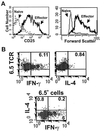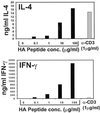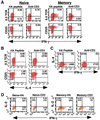Functional plasticity of an antigen-specific memory CD4 T cell population
- PMID: 12192093
- PMCID: PMC129349
- DOI: 10.1073/pnas.192263099
Functional plasticity of an antigen-specific memory CD4 T cell population
Abstract
The protective nature of memory immune responses is attributed largely to terminally differentiated memory T cells that retain memory of the antigen via the antigen receptor and memory of the effector functions that initially cleared the pathogen. It is not known whether a given population of antigen-specific memory T cells is endowed with functional flexibility to provide protective responses against antigens reencountered in different immunological contexts. Here, we examine functional properties of influenza hemagglutinin (HA)-specific memory CD4 T cells recovered from adoptive hosts that received in vitro-activated HA-specific T cell receptor-transgenic CD4 T cells 2 months to 1 year previously. We demonstrate that this HA-specific memory CD4 T cell population bearing a clonal T cell receptor can produce predominantly T helper 1 or T helper 2 effector cytokines depending on the nature of the recall stimulus. Our findings reveal remarkable functional plasticity within an antigen-specific memory T cell population and have direct implications for modulating memory T cell function in vaccine design and treatments for autoimmune diseases.
Figures




Similar articles
-
Antigen-specific CD4 T cell clonal expansion and differentiation in the aged lymphoid microenvironment. II. The memory T cell response is diminished.Mech Ageing Dev. 2004 Jan;125(1):59-68. doi: 10.1016/j.mad.2003.10.003. Mech Ageing Dev. 2004. PMID: 14706238
-
The effector to memory transition of CD4 T cells.Immunol Res. 2008;40(2):114-27. doi: 10.1007/s12026-007-8004-y. Immunol Res. 2008. PMID: 18213525 Review.
-
Memory CD4 T cells direct protective responses to influenza virus in the lungs through helper-independent mechanisms.J Virol. 2010 Sep;84(18):9217-26. doi: 10.1128/JVI.01069-10. Epub 2010 Jun 30. J Virol. 2010. PMID: 20592069 Free PMC article.
-
Low-dose antigen-experienced CD4+ T cells display reduced clonal expansion but facilitate an effective memory pool in response to secondary exposure.Immunology. 2008 Mar;123(3):426-37. doi: 10.1111/j.1365-2567.2007.02707.x. Epub 2007 Oct 4. Immunology. 2008. PMID: 17916164 Free PMC article.
-
Generation, persistence and plasticity of CD4 T-cell memories.Immunology. 2010 Aug;130(4):463-70. doi: 10.1111/j.1365-2567.2010.03288.x. Epub 2010 May 10. Immunology. 2010. PMID: 20465569 Free PMC article. Review.
Cited by
-
Flexibility accompanies commitment of memory CD4 lymphocytes derived from IL-4 locus-activated precursors.Proc Natl Acad Sci U S A. 2008 Jul 8;105(27):9307-12. doi: 10.1073/pnas.0704807105. Epub 2008 Jun 30. Proc Natl Acad Sci U S A. 2008. PMID: 18591677 Free PMC article.
-
Harnessing the plasticity of CD4(+) T cells to treat immune-mediated disease.Nat Rev Immunol. 2016 Mar;16(3):149-63. doi: 10.1038/nri.2015.18. Epub 2016 Feb 15. Nat Rev Immunol. 2016. PMID: 26875830 Review.
-
Effector T cell plasticity: flexibility in the face of changing circumstances.Nat Immunol. 2010 Aug;11(8):674-80. doi: 10.1038/ni.1899. Epub 2010 Jul 20. Nat Immunol. 2010. PMID: 20644573 Free PMC article. Review.
-
Plasticity within the αβ⁺CD4⁺ T-cell lineage: when, how and what for?Open Biol. 2013 Jan 23;3(1):120157. doi: 10.1098/rsob.120157. Open Biol. 2013. PMID: 23345540 Free PMC article. Review.
-
CD4 responses to conserved HIV-1 T helper epitopes show both negative and positive associations with virus load in chronically infected subjects.Clin Exp Immunol. 2003 Dec;134(3):454-63. doi: 10.1111/j.1365-2249.2003.02307.x. Clin Exp Immunol. 2003. PMID: 14632751 Free PMC article.
References
Publication types
MeSH terms
Substances
Grants and funding
LinkOut - more resources
Full Text Sources
Other Literature Sources
Research Materials

